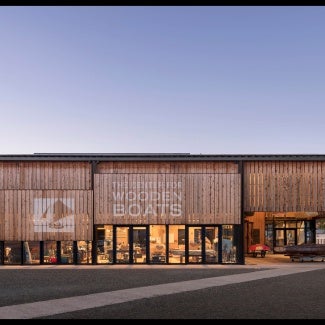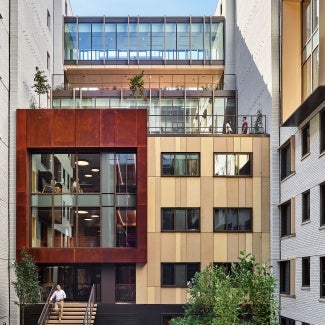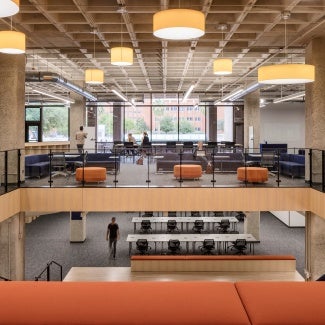Worcester Blackstone Visitor Center
The award-winning contemporary architecture of the Worcester Blackstone Visitor Center uses sustainable design interventions to rejuvenate the village and heal the land from the harmful environmental byproducts of industrialization.

Project highlights: Worcester Blackstone Visitor Center
- Architect: designLAB architects
- Owner: Blackstone Heritage Corridor/MassDOT
- Location: Worcester, Mass.
On a former industrial complex in Worcester, Massachusetts, the Worcester Blackstone Visitor Center tells the story of the site and surrounding community without using historic artifacts. Through its sustainable design interventions, including remediation of the former brownfield site, the center seeks to help heal land damaged by industrial processes and the community that bore the brunt of the United States’ industrial evolution.
The site’s history stretches back to 1795 when a paper mill opened along the banks of the Blackstone River. In the late 1800s, the site was home to American Steel & Wire, which churned out iron products at three plants across Worcester until it ceased operations in 1977, leaving behind shells of buildings and a toxic brownfield. As American industrialization declined in the mid-20th century, so did the quality of life for those living in Quinsigamond Village, just across the river from the site.
Ultimately, the visitor center aims to support the rejuvenation of the village, once home to many millworkers who suffered greatly from the harmful environmental and economic byproducts of industrialization. The design strategy reiterates the intertwined histories of the site and village through form, materials, and industrial iconography. Steel site frames span the center and its adjacent walkway, creating the sensation of standing in a large, industrial site, though the center is a modest 11,000 square feet. The technique helped manage the financial constraints of the project, which totaled just $14.5 million, without compromising the desired effect.
Steel and wire details throughout reference the former manufacturer, while the center’s folded roof plane responds directly to the original mill building’s distinct sawtooth monitors. Much of the project’s wood and brick materials were salvaged from nearby industrial sites. A new pedestrian bridge spurs interactions with the river, now an asset after a decades-long remediation effort. The roar of a nearby highway is dampened by the sound of water that rushes over the dam that once helped power the complex.
The team employed numerous design strategies that provide social, economic, and environmental value, but the event pavilion at the edge of the site encompasses all three. Capped with a 70 kW photovoltaic array that provides more than half of the center’s energy, the pavilion infrastructure supports concerts and other events that generate revenue for the center. Outside of scheduled events, the pavilion provides a shaded space for informal gatherings or exercise.
The site, once deeply scarred by decades of industry, is once again green, and the adjoining village is richly diverse. Since opening in 2018, the center has hosted scores of community events, school groups, and other tourists, helping Quinsigamond Village continue to regain its footing.
Project team & jury
Landscape Architect: Landworks Studio
Civil Engineer: AECOM
Structural Engineer: Structures Workshop
MEP/FP: Architectural Engineers Inc
General Contractor: Daniel O'Connell's Sons
Ashley Wilson, FAIA, Chair, Ashley Wilson Architect, Alexandria, Va.
Jose Leo Arango, Assoc. AIA, EYP, District of Columbia
Randall Deutsch, FAIA, University of Illinois at Urbana-Champaign School of Architecture, Champaign, Ill.
Gabriel Ignacio Dziekiewicz, AIA, DesignBridge, Chicago
Teresa Jan, AIA, Multistudio, San Francisco
Luis Nieves-Ruiz, East Central Florida, Regional Planning Council, Orlando, Fla.
Zakiya Wiggins, AIA, LS3P, Raleigh, N.C.
The Architecture Award celebrates the best contemporary architecture regardless of budget, size, style, or type and highlight the many ways buildings and spaces improve our lives.
Sixteen projects showcase the best contemporary architecture and show the world the range of outstanding work created by architects.













